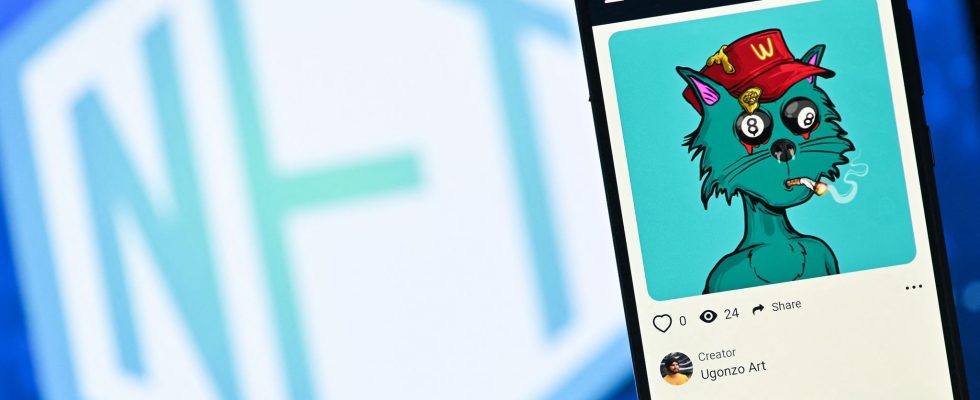One more trend that is falling like a blast. After experiencing their golden age, NFTs (non-fungible tokens) have been in serious decline for several months. These digital tokens, the contours of which still remain nebulous for a large majority of Among us, 95% of them would have lost almost all of their value.
In any case, this is what is stated DappGambl, a site specializing in cryptocurrency, which combed through more than 73,000 collections of NFTs “in order to identify key trends, assess the health of the market, determine the factors that contribute to the success of projects and, hopefully, gain insights into the potential future trajectory of the NFT ecosystem.” And the result is clear. Of the 73,257 collections identified, 69,795 of them have a market capitalization equivalent to 0 Ether (ETH). And only “1% are valued above $6,000”. Enough to dampen the hopes of the 23 million NFT holders who expected to see their investment transform into a real gold mine.
An overvaluation of the market from 2021
It’s hard to imagine that two years earlier, NFTs ignited the web, sparking a real frenzy among millions of Internet users. In August 2021, the monthly transaction volume reached $2.8 billion. And although it is estimated at around ten dollars today, the NFT of Twitter founder Jack Dorsey’s first tweet sold for almost $3 million in March 2021. However, “by the end of the year 2021, the actors of Web3 (generic term to designate the vision of a decentralized Internet belonging to the user, Editor’s note) knew full well that the NFT market was largely overvalued. At the same time, we saw the arrival of the bear market (a slowdown in the market which extends over a period of at least two years, Editor’s note) at the start of 2022, and we very quickly understood that NFTs would not escape the trough of the wave”, remembers Raphaël Deshayes Dijeau, Web3 specialist and general director of the start-up The Crypto Show.
But sucked in by this euphoric whirlwind, tens of thousands of players are flourishing, flooding the exchange platforms with new NFTs. By launching their own collections, many brands, like McDonald’s, Starbucks, Puma, Adidas, Dolce & Gabbana and Dior, are also shining the spotlight on these new active ingredients. “Brands quickly grasped the potential of NFTs and the interest they could have, particularly in building customer loyalty,” explains Jean-Charles Capelli, president of Dubit which produces experiences in the metaverse.
The arrival of new players
But the accession of actors from the “classic” economy to the NFT ecosystem was not enough to protect it from its dizzying fall. For Raphaël Deshayes Dijeau, this massive arrival of foreign players on Web3 may have even accelerated the collapse of their value. “The so-called ‘artistic’ NFTs, which we most often saw in profile photos, were the most likely to give rise to speculative logic. However, at the end of 2021, many people arrived with the desire to create a significant profitability. They therefore launched collections of NFTs whose value was based solely on the artistic aspect, and then had almost no use. These collections were not created to last, but to bring in as much money as possible in a minimum of time. It was obvious that once the trend passed, holders would sell their NFTs, and that the market would collapse.”
Another sign of growing public disinterest is that nearly 79% of the collections have still not been sold in their entirety. An observation which highlights the striking imbalance between the number of NFT projects and real demand. “This excess of supply over demand is creating a buyer’s market where potential investors are becoming increasingly discerning, carefully evaluating the style, uniqueness and potential value of NFTs before making a purchase,” analyzes the report from the Dappgambl website.
All is (perhaps) not lost
“It’s the end of a period of great excitement, the market is changing face: speculative NFTs are declining while ‘practical’ NFTs are developing. Tomorrow, they will be used in very different and much more varied situations. By example, to transport our contacts and our followers on social networks from one platform to another”, explained in August to L’Express Pierre-Nicolas Hurstel, CEO of Arianee, a French company which allows brands (Le Printemps, Richemont, Casino, etc.) to use NFTs for use cases relevant to the real world and customer engagement.
Although today the outlook seems bleak, the site specializing in cryptocurrency puts things into perspective. “NFTs still have a place in our future”, assures DappGambl, which however insists on the need to respect a certain number of conditions: they must have “lasting value”, that they be “true works of art”. ‘art’, ‘historically relevant’, or that they provide ‘real utility’.
Others, like Jean-Charles Capelli, also continue to believe in the potential of these digital assets. “When we talk about NFTs, everyone immediately thinks of images. The general public does not know 3/4 of the functionalities of an NFT, even though it is a formidable Swiss army knife, which can be very interesting for economic players who seek to strengthen the commitment of their customers”, insists the president of Dubit. All is (perhaps) not lost.
